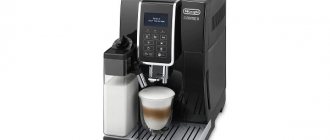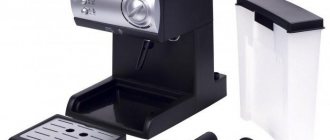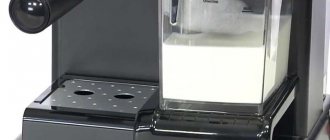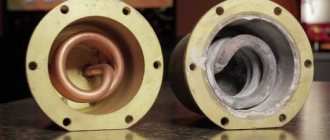Reading time: 6 minutes. Published 12/15/2019
To enjoy the impeccable taste of your coffee cup after cup, we recommend that you descale your coffee machine regularly.
- Descaling set suitable for all models of Nespresso coffee machines
- Contains two 100 ml sachets of cleanser
- Use one sachet to clean the coffee machine
- The kit contains instructions for safe use
A detailed description of the descaling process can be found in the operating instructions for your coffee machine.
- Net weight of the set: 200 ml
- Set shelf life: 2 years
- Country of origin: Switzerland
To enjoy the impeccable taste of your coffee cup after cup, we recommend that you descale your coffee machine regularly.
- Descaling set suitable for all models of Nespresso coffee machines
- Contains two 100 ml sachets of cleanser
- Use one sachet to clean the coffee machine
- The kit contains instructions for safe use
A detailed description of the descaling process can be found in the operating instructions for your coffee machine.
- Net weight of the set: 200 ml
- Set shelf life: 2 years
- Country of origin: Switzerland
Hard water is an everyday reality in our homes. Therefore, it is enough to neglect cleaning the Nespresso for a short time in order to then deal with a thick layer of scale on its parts. After all, some minerals, such as calcium and magnesium, affect the formation of scale when exposed to temperatures above 550C.
Calcified deposits not only affect the taste of the coffee, but also significantly reduce the performance of the machine. However, there are many home remedies that will magically help remove plaque.
To ensure that your equipment always works properly, it is useful to know how to descale your Nespresso coffee machine at home.
Selecting cleaning products
There are several ways to clean a Nespresso capsule or carob coffee machine. For this purpose, you can purchase the original Delonghi Ecodecalk liquid of 500 ml. The quantity is enough for 4 – 5 uses, since the solution is concentrated. The composition includes several acids:
- lemon;
- maleic – a derivative of malic acid, a safe substance for health;
- phosphonic - prevents the rapid appearance of new sediment on the walls of parts.
All components are selected and designed in such a way that after the final rinsing, no harmful substances are detected in the coffee, and the walls of the tubes and main parts are not damaged by chemicals.
If you use improvised means, it will cost less. True, the complete cleaning cycle will have to be repeated 3–4 times to completely remove scale. Use citric acid or vinegar in diluted form.
If there is no specialized product for decalcifying a Nespresso coffee machine in the store, according to the instructions, you can use other products, for example, intended for other brands of machines.
Which acid to choose
The ideal solution in the fight against calcified formations on the walls of the coffee machine is vinegar. It contains acetic acid, which is a weak organic acid.
The substance can treat internal surfaces even with a minimum volume. Appropriate amounts of vinegar should be applied depending on the degree of contamination of the stone.
Vinegar is a natural and toxic waste-free product. Its acidic properties help get rid of scale, mineral deposits and even the coffee oil left behind from the beans. Citric acid also helps in the fight against scale.
In other cases, special chemicals that are sold in stores and supplied in liquid or crystalline form will help. They most often contain organic sulfamic acid, which is an excellent product for a coffee machine and much safer for various types of metals.
How often should you wash your car?
Nespresso should be cleaned at least once every three months. If you do not brew coffee often, then you can focus on the number of servings made - the norm is 300 pieces, after which the machine is washed.
It is recommended to test the water for the presence of salts. The following may be present in dissolved form in tap liquid:
- Iron salts. The color of the deposits will have a reddish tint.
- Magnesium and calcium salts.
- Ions of other metals, such as aluminum.
- Gases.
When heated, they form hard, porous deposits that interfere with the normal operation of the device.
Distilled water contains no impurities, making it an ideal liquid for coffee machines. If you have a built-in reverse osmosis filter at home, it is recommended to use such water to fill the coffee maker container.
If you use tap liquid, cleaning will have to be done more often. How often can be determined by the scale in the kettle. If a thick layer accumulates on the inner walls within a month, then the coffee maker needs to be cleaned twice a month.
If you calculate the costs of bottled water and compare them with the purchase of professional descalers, then it will be cheaper to buy water in a store.
Detergents
There are plenty of professional coffee machine care products in stores. When purchasing them, you must read the instructions for use, taking into account the recommendations of the equipment manufacturers.
In addition to store-bought household chemicals, experienced housewives, for example, use traditional methods to descale a Nespresso coffee machine. The option of washing with citric acid is no less effective than using professional products.
The main advantages of this “grandmother’s” method include:
- Efficiency;
- Safety and environmental friendliness;
- Inexpensive cost.
Even if, after descaling the machine, small crystals of citric acid remain in it, this will not cause harm to health, unlike chemicals.
Lemon acid
Cleaning kit from the manufacturer
The manufacturer has specially developed chemicals for cleaning Nespresso krups coffee machines and other types of capsule or carob units. For built-in cappuccino makers, additional liquids or tablets are available to remove residual milk fat from the walls of the container and the conductive tubes.
There is a separate liquid from the oily residue that forms in the cooking group, but most often two ingredients are combined in one product, simultaneously cleaning all contaminants.
Important! You need to start cleaning when the descaling nespresso sign lights up. If you delay the procedure, the machine may not turn on and decalcification will only be possible at a service center, which will cost much more and take longer
Cleaning process
Cleaning a Nespresso or Delonghi coffee machine using a lemon squeezer does not take much time and consists of several steps.
- It is necessary to fill the water tank with 3-4 tablespoons of the product diluted in 1 liter of water.
- Then wait 15 minutes until the citric acid completely dissolves and begins to act.
- Next, the coffee brewing function is turned on, and this process is repeated several times until all the water in the reservoir is used up.
- Then the device is turned off, opened, and all surfaces are carefully wiped with a damp microfiber cloth.
- After everything is washed and put in place, clean water is poured into the water container and the drink preparation mode is started a couple of times.
This method copes well with the formation of scale in any coffee machines.
Lemon is a universal cleaner
The instructions for descaling commercial products contain recommendations for use, but the entire process is covered in detail only in the documentation for the equipment. In any case, such information is present in the books for Nespresso and Delonghi coffee machines.
The general process is not much different from the one above using citric acid. It’s just that instead of lemon juice, household chemicals are dissolved in water. Here, the main thing is to pay more attention to the subsequent rinsing in order to remove all residual product from the surfaces; they should not get into the finished drink.
Step-by-step instructions for nespresso descaling
Instructions for cleaning Nespresso Delonghi capsule and regular:
- Remove grounds from the waste container or used capsules and clean the drip tray.
- Prepare a solution of descaling agent as written in the manual.
- Pour it into the water container and start the cleaning mode. Place a cup under the spout that can hold the entire amount of liquid from the reservoir.
- After the first cleaning cycle, some manufacturers recommend pouring the cleaning solution back into the reservoir and starting the process again.
- Pour the used liquid into the toilet.
- Pour clean water into the container and rinse the system once. When using original cleaning solutions, once is enough.
Next, you should rinse the pan and water tank under the tap and install them in place. If there is a remote milk jug, it is washed under the tap; if there is a built-in cappuccino maker, it is washed along with the entire device with chemicals and then with clean liquid.
How to descale Nespresso
The process of cleaning calcified deposits from a coffee machine is divided into two stages:
- Cleaning removable parts from dirt - wash all parts of the machine with warm water or wipe with a damp sponge.
- Descaling – Use active reagents to remove deposits from the water tank.
Such simple steps will not only help to wash away plaque, but will also cover parts of the coffee machine with a protective layer, which will prevent the formation of oils and coffee residues, as well as deposits of calcium salts for a long time, which will significantly increase the service life of kitchen equipment.
Remove scale with vinegar
What you will need:
- coffee machine;
- water;
- table vinegar;
- hot water;
- sponge;
- dry towel.
Nespresso descaling instructions:
- Drain the reservoir, rinse it and clean out any coffee grounds that remain in the filter.
- Make a solution of water and vinegar - fill the chamber to full volume with equal parts of water and acetic acid.
- Run half of the brew cycle. Turn off the coffee machine and leave it for an hour.
- Finish the brewing cycle - after an hour, turn on the equipment and finish the cycle.
- Discard the vinegar liquid and run a new cycle with clean water. Repeat twice to get rid of any remaining vinegar.
- Wipe down the appliance and wash tanks and other removable containers in hot soapy water.
- Put the car back together and make yourself a big cup of coffee!
How often to descale your Nespresso
Tablets for cleaning coffee machines.
The coffee machine is cleaned once every 3 months.
The frequency of removing deposits from equipment depends on the quality of the water used to prepare the drink.
An excellent solution is to use special tablets (liquids) to remove plaque from water tanks.
Unfortunately, such drugs are not always freely available. Plaque is calcium compounds.
Note! It is possible to use products available at home as a decalcifier: acid-containing substances.
How to use it correctly
How to use the N espresso capsule coffee machine? There are no complicated intricacies here; the use of such a device is simplified to the limit - this is one of its main advantages:
- Pour water into the compartment.
- Place the capsule in its place.
- Click the “Start” button.
Next, the device heats the water, after which the coffee is prepared directly. The total time is only about 30 seconds.
Possible problems and their elimination:
- the machine does not respond to commands - most likely, the power cord or control unit has failed. There may have been a short circuit;
- the temperature of the coffee is lower than it should be - the fault is with low-quality tap water, which over time has formed the ubiquitous scale on the heating element;
- the capsule does not pierce or is stuck - the problem is in the seals, or you need to replace the entire press or just the piercer. In this case, repair of the coffee machine is carried out by a specialized service.
There are many different types of capsules available for the device.
Cleaning a coffee maker is a simple process, but it must be done to avoid machine breakdown, as well as the formation of mold and harmful pathogenic bacteria:
- Every day you need to clean the drip tray - to do this, remove it, add some dish soap, remove scale (if any) and wipe with a clean cloth. Then rinse with warm water and air dry. The capsule container is cleaned in the same way;
- The water tank and its lid should be washed daily, also using dish soap. It is forbidden to leave water in the tank;
- The capsule entry sensor must be wiped with a soft cloth, without water or chemicals;
- Descaling is done every 3 months or after using every 300 capsules. For this purpose, the coffee machine has a special mode. As a remover, you can use a proprietary solution or make your own, which contains water, as well as lemon juice, citric acid or vinegar.









